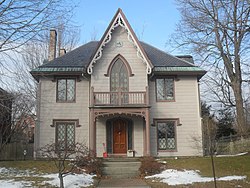
The William Blacklock House is a historic house at 18 Bull Street in Charleston, South Carolina. A National Historic Landmark, this brick house, built in 1800 for a wealthy merchant, is one of the nation's finest examples of Adamesque architecture. It is now owned by the College of Charleston, housing its Office of the foundation.

The Lake–Peterson House, also known as Jenny's, is a Victorian Gothic Revival home in Rockford, Illinois, United States. The house was built in 1873, probably by prominent Rockford citizen John Lake - its first owner, but its architect is unknown. The house is a significant example of Gothic Revival architecture and is considered one of the finest such homes in the U.S. state of Illinois. The Lake–Peterson House is owned and maintained by Swedish American Hospital in Rockford and stands adjacent to the main hospital complex along Business US 20. The building and its carriage house were added to the U.S. National Register of Historic Places in 1980.

The First Universalist Church is a historic church building on the corner of Pleasant, Elm, and Spring Streets in Auburn, Maine. It was built in 1876 to a design by John Stevens of Boston, Massachusetts, and has been a significant landmark in the city since its construction. It is a fine local example of Gothic Revival architecture executed in brick, and was listed on the National Register of Historic Places in 1979.
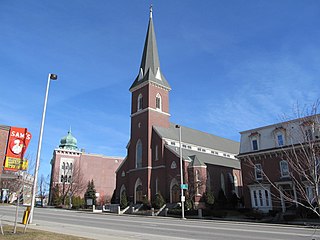
St. Joseph's Catholic Church is a historic former church building at 257 Main Street in Lewiston, Maine. Built 1864–67, it was the first Roman Catholic church in the city, and is one of only two surviving buildings in the state designed by Patrick C. Keely. It was listed on the National Register of Historic Places in 1989. The church closed in 2009, and was in 2013 threatened with demolition. Alternative uses for the structure are still being sought.

Winthrop Street Baptist Church is a historic Baptist church located at 39 Winthrop Street in Taunton, Massachusetts, USA. The Late Gothic Revival church was built in 1862 and was the second Baptist church built on the site. It was added to the National Register of Historic Places in 1984.

The Cathedral of the Immaculate Conception is a historic cathedral at 307 Congress Street in Portland, Maine that serves as seat of the Diocese of Portland. The pastor is Bishop Robert Deeley, and the rector is Father Seamus Griesbach. The church, an imposing Gothic Revival structure built in 1866–69, was listed on the National Register of Historic Places in 1985. It is the tallest building in Portland and the third tallest in Maine.
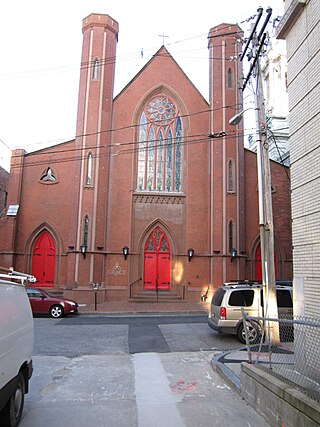
The former Chestnut Street Methodist Church is an historic church building at 15 Chestnut Street in Portland, Maine. Built in 1856, it is rare in the city as an early example of Gothic Revival architecture, and is one of the few surviving works of Charles A. Alexander, a popular architect of the period. The building was listed on the National Register of Historic Places in 1977. It now houses a restaurant.

St. Paul's Church and Rectory is an historic Episcopal church at 279 Congress Street in Portland, Maine. Built in 1868 for a newly established congregation, it is a fine local example of Gothic Revival architecture, designed by English architect George Browne Pelham. It was listed on the National Register of Historic Places in 1978. The present pastor is Rev. Samuel L. Logan.

The South Parish Congregational Church and Parish House is a historic church at 9 Church Street in Augusta, Maine. Built in 1865, the church is a major Gothic Revival work of Maine's leading mid-19th century architect, Francis H. Fassett, and its 1889 parish house, designed by James H. Cochrane, is a rare example in the state of Stick style architecture. The property was listed on the National Register of Historic Places in 1980. The congregation was established in 1773, when the area was part of Hallowell.

The Second Congregational Church is a historic church on River Street in Newcastle, Maine. Built in 1848, it is one of Mid Coast Maine's finest examples of brick Gothic Revival architecture. It was listed on the National Register of Historic Places in 1979. The congregation, established in 1843, is affiliated with the United Church of Christ.

The Winter Street Church, originally known as the Winter Street Congregational Church, is an historic former Congregational church at 880 Washington Street, corner of Winter Street in Bath, Sagadahoc County, Maine. Built in 1843-44, it is a fine early example of Gothic Revival architecture, designed and built by a local master builder. It was listed on the National Register of Historic Places on July 27, 1971. The building was saved from destruction by Sagadahoc Preservation Inc. in 1971, and is now called the Winter Street Center.

The Sparrow House is an historic house at 35 Arlington Street in the Woodford's Corner and Back Cove neighborhood of Portland, Maine. Built in 1852, it is a well-preserved example of Gothic Revival architecture. It was listed on the National Register of Historic Places in 1982.
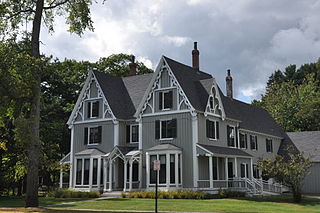
The Henry Boody House also known as the Boody-Johnson House, is an historic house at 256 Maine Street in Brunswick, Maine, United States. Built in 1849, it is an important early example of Gothic Revival Architecture, whose design was published by Andrew Jackson Downing in 1850 and received wide notice. It was listed on the National Register of Historic Places on 1975.
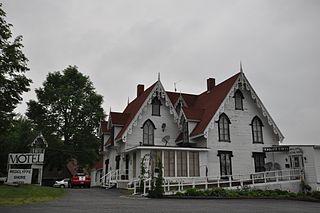
The Henrietta Brewer House, originally The Cottage House and now Redclyffe Shore Motel, is a historic private residence located on U.S. Route 1 in Robbinston, Maine, United States. Erected between 1861 and 1863, the house is one of the finest examples of high-style Gothic Revival architecture in Down East Maine. The house was listed on the National Register of Historic Places in 1983. Cabins built along the Passamaquoddy Bay are used as motel units.

The Seavey-Robinson House is a historic house built in the Carpenter Gothic style in South Portland, Maine. Built c. 1854–57, it is a rare example of a Carpenter Gothic cottage, originally built in a rural setting, since urbanized. It was added to the National Register of Historic Places in 1986.

The Elisha F. Stone House is a historic house at the corner of High and Gothic Streets in South Paris, Maine. Built in 1854, it is one of the finest Gothic Revival houses in Oxford County. The house was designed by Portland-based Henry Rowe, and built for Elisha F. Stone, a local merchant, tailor, and postmaster. It was listed on the National Register of Historic Places in 1983.
The A. B. Leavitt House is a historic house on Main Street in the Sherman Mills village of Sherman, Maine. Built in 1890, the house is a high-quality and well-preserved example of Gothic Revival mail-order architecture, being a nearly-intact and faithful rendition of a design pattern published by the architectural firm of Palliser, Palliser & Company, deviating only in the addition of a carriage house. The house was listed on the National Register of Historic Places in 1986.
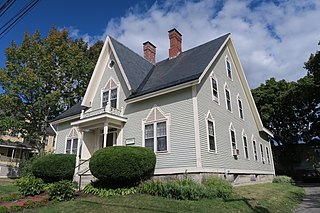
The Charles W. Jenkins House is a historic house at 67 Pine Street in Bangor, Maine. Built in 1845–46, it is a well-preserved example of a Gothic Revival cottage in an urban setting. The house was listed on the National Register of Historic Places in 1990.

The William F. Grant House is a historic house at 869 Main Street in North Vassalboro, Maine. Built in 1850 by a Scottish immigrant, it is a distinctive local example of Gothic Revival architecture. It was listed on the National Register of Historic Places in 2006.
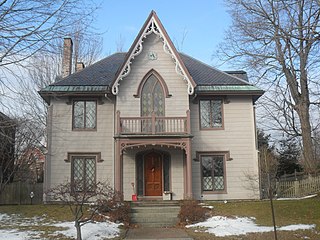
Henry Rowe was an Irish architect who practiced in nineteenth-century Massachusetts, New York and Maine. One of his most noted designs is The Gothic House, in the Spring Street Historic District of Portland, Maine, which was built in 1845. It is believed to be Rowe's first commission in the state, and is described in city promotional materials as the finest example of Gothic Revival architecture in Maine.
